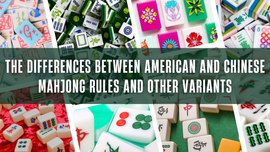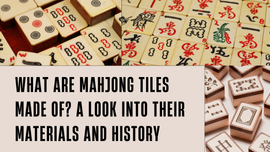Flowers Tiles (also known as bonus tiles) are collection of both flower and season tiles. There isn't any standard or set graphic for these tiles and may vary from set to set what is show here. Most commonly, however flowers are just depicted. Other themes may include occupations (fisherman, woodcutter, farmer, and master), means of transportation, or structures (bridge, gate, pavilion, and pagoda)
What Are Mahjong Flower Tiles?
Flowers and season tiles are different in nature from the suit and honor tiles. There are only 4 flowers (1, 2, 3, and 4) and only 4 season tiles (1, 2, 3, and 4). When drawn, they are declared and a substitute tile is drawn. The flower(s) or season(s) corresponding with the winning player's wind may increase the score.
The Flowers are represented by a plum, orchid, chrysanthemum and bamboo. Whereas the Seasons are depicted by a fisher, woodcutter, farmer and scholar.
| Flower | Season/Occupation | Number | Corresponding Wind |
| Plum ( 梅) | Spring ( 春) /Fisherman | 1 | East |
| Lily/Orchid ( 兰) | Summer ( 夏) /Woodcutter | 2 | South |
| Chrysanthemum (菊) | Autumn ( 秋) /Farmer | 3 | West |
| Bamboo ( 竹) | Winter ( 冬) /Scholar | 4 | North |
Each of these tiles represents a specific season or flower and plays a role in enhancing your chances of scoring more points. Flower tiles are not used to form melds (sets of three or four tiles) like other tiles; instead, they are revealed immediately upon drawing and replaced with another tile from the dead wall.
How Flower Tiles Work and Affect Gameplay
Replacement Rule
When a player draws a flower tile during their turn, they typically must immediately reveal it to the rest of the table and draw a replacement tile from the dead wall. This ensures that flower tiles don’t interfere with the player’s ability to build a traditional winning hand. The bonus points provided by flower tiles come into play during the scoring phase at the end of a hand.
Bonus Points
In many Mahjong variants, flower tiles are tied to a player’s seat wind. If the season or flower tile matches the player’s current seat wind, they receive extra points. For example, if a player is seated in the East position and they draw the Spring flower tile, they receive additional points because Spring corresponds to the East wind.
Strategic Use
Flower tiles add an element of luck to Mahjong. While you cannot control when you draw a flower tile, strategically managing the points they provide can influence your final score. Drawing matching flowers for your seat wind is ideal, but drawing any flower tile still gives you a bonus, even if it doesn’t align with your wind.
Variations of Flower Tile Rules in Different Mahjong Versions
American Mahjong
Flower tiles in American Mahjong have a distinct role. While American Mahjong uses many of the same core tiles as other versions, its the National Mah Jongg League (NMJL) rules that define flower tiles as wild cards in certain situations. They can substitute for specific tiles when completing hands, based on the current year’s card of hands and rules. However, flower tiles are often crucial in completing high-scoring hands, and their appearance triggers an immediate replacement draw from the wall.
In American Mahjong:
- Flowers are treated as bonus tiles but are often required in specific hands outlined in the yearly card.
- Flower tiles do not form part of a "pure hand, but they often have a role in completing joker-free combinations.
- Scoring: Flower tiles help complete hands that require specific numbers of flowers. Unlike other Mahjong variants, where flowers mainly offer points, in American Mahjong, they are frequently part of a winning hand's structure.
Hong Kong Mahjong
In Hong Kong Mahjong, flower tiles provide direct bonus points, usually one point for each flower tile drawn. If the flower tile matches the player’s wind seat, they receive double the bonus. Hong Kong Mahjong emphasizes the role of flower tiles, making them highly valuable in adding to your score.
Singapore Mahjong
Singapore Mahjong has an interesting twist on flower tiles, incorporating animal tiles (Cat, Rat, Rooster, Centipede) into the flower tile system. These animal tiles function similarly to flower tiles in terms of bonus points but add extra strategic depth. Matching specific predator-prey pairs of animals (e.g., Cat and Rat) can yield even more points.
Taiwan Mahjong
In Taiwan Mahjong, flower tiles also contribute bonus points, and the game includes an extra layer of complexity with “flowers” that can impact scoring. Similar to Hong Kong Mahjong, each flower tile provides a single point, and matching your seat wind’s corresponding flower increases the reward.
Japanese Mahjong (Riichi)
Interestingly, Riichi Mahjong typically does not use flower tiles. This variant focuses on its unique rules like Dora indicators, which serve a similar role to flower tiles in adding bonus points but are not specific tiles in the hand.
Scoring with Flower Tiles
Flower tiles can greatly impact a player's score, depending on the variant. Below is a typical scoring breakdown for flower tiles in many Mahjong versions, including American Mahjong:
| Flower Tile Drawn | Bonus Points |
|---|---|
| 1 Flower Tile | +1 point |
| Matching Flower for Seat Wind | +2 points |
| Full Set of Flowers (4 Tiles) | +4 points |
| Full Set of Seasons (4 Tiles) | +4 points |
Collecting Flower Tiles: Strategies and Tactics
When to Collect Flower Tiles
Because flower tiles are typically drawn and replaced immediately, you have no control over whether you get them or not. However, understanding how flower tiles contribute to your score can help you adjust your strategy. If you are drawing multiple flower tiles, it may be wise to focus on completing a higher-scoring hand rather than rushing to complete your melds.
Maximizing the Benefit
If you draw flower tiles that match your seat wind (East, South, West, North), you stand to gain additional bonus points. Additionally, if you are lucky enough to draw all four seasons or all four flower tiles, you earn an even larger score. Keep an eye on which tiles other players are drawing as well, as this may give you insight into their potential bonuses.
Example: A Game-Changing Flower Tile
Imagine drawing the last tile of a hand and finding it is a flower tile that matches your seat wind. You quickly replace the tile, complete a winning hand, and add the flower tile’s bonus points to your score. This unexpected bonus could be the difference between a narrow win and a decisive victory.
Flower Tiles in American Mahjong: Special Considerations
In American Mahjong, flower tiles have a much more complex role than in other variants. They are frequently part of special hands and are necessary to complete some of the most challenging hands in the yearly card published by the National Mah Jongg League.
Wild Card Use
While flower tiles themselves are not used as wild cards, the presence of flower tiles can affect how other wild cards (like jokers) are used in American Mahjong. Jokers can sometimes substitute for missing tiles when a hand requires flowers, increasing the value and importance of flowers in American Mahjong hands.
Winning Hands with Flower Tiles
Certain winning hands require players to collect a specific number of flower tiles in addition to other combinations. A player who lacks the necessary flower tiles may struggle to complete these hands, making flower tiles a valuable commodity during play.
Common Questions About Flower Tiles
Can flower tiles help me win directly?
No, flower tiles are bonus tiles that do not count towards your winning hand. However, they add extra points to your score at the end of the round.
Are there any situations where I don’t want to draw flower tiles?
In rare cases, if you’re close to completing a winning hand, drawing a flower tile could delay your progress since you must replace it. However, the bonus points typically outweigh this minor inconvenience.
What happens if I draw multiple flower tiles in one turn?
If you draw multiple flower tiles, you must reveal and replace all of them in the same turn. You may end up with a fresh hand that drastically changes your chances of winning.
Flower Tiles in Modern Mahjong Sets
Many Mahjong sets today feature beautifully designed flower tiles, often with intricate artwork reflecting traditional Chinese symbolism or local culture. Some modern sets even replace flower tiles with other symbolic tiles like zodiac animals or unique artistic designs, adding a fresh aesthetic to the game. Regardless of the design, flower tiles maintain their crucial role in enhancing gameplay and scoring potential.
In some more modern and/or Westernized American Mahjong, flower tiles tend to feature more minimalist designs, aligning with the specific hands listed in the NMJL cards. These tiles are essential for completing certain hands, making their design both functional and aesthetic.
Flower tiles bring an exciting dimension to Mahjong, providing players with the opportunity to earn bonus points and influence the flow of the game. While they cannot directly help you form a winning hand, flower tiles often serve as the extra edge that leads to victory. Understanding how flower tiles function across various Mahjong variants and knowing how to strategically manage them is key to becoming a more skilled player. No matter what variant of Mahjong, mastering the art of flower tiles can make all the difference.

